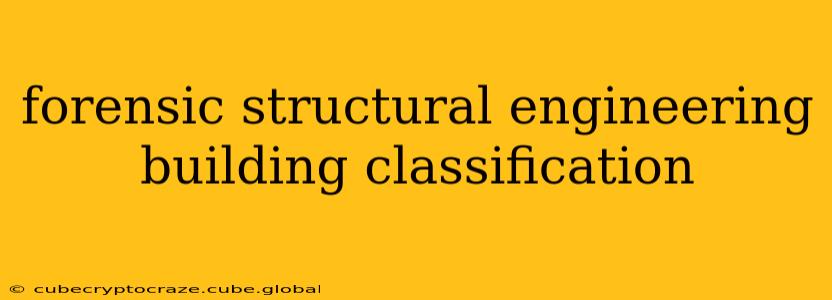Forensic structural engineering delves into the causes of building failures, collapses, and damage. A crucial first step in any forensic investigation is classifying the building itself. This classification helps engineers understand the building's design, construction methods, materials, and potential vulnerabilities, guiding the subsequent investigation efficiently and effectively. This post will explore various aspects of building classification relevant to forensic structural engineering.
What is Forensic Structural Engineering?
Forensic structural engineering is a specialized field applying engineering principles to investigate structural failures, collapses, and damage. It involves meticulous examination, analysis, and reporting to determine the root cause of a structural incident. This often includes assessing liability, insurance claims, and contributing to legal proceedings. The work requires a deep understanding of structural mechanics, materials science, construction practices, and legal processes.
How are Buildings Classified for Forensic Investigations?
Building classification for forensic investigations isn't standardized across the globe, but several key factors are consistently considered:
1. Building Type:
This is arguably the most important initial classification. Common building types include:
- Residential: Single-family homes, apartments, condominiums.
- Commercial: Offices, retail spaces, shopping malls.
- Industrial: Factories, warehouses, power plants.
- Institutional: Schools, hospitals, government buildings.
- Agricultural: Barns, silos, greenhouses.
The building type significantly influences the expected design loads, construction techniques, and materials used. For example, an industrial building might experience much higher dynamic loading than a residential building.
2. Construction Materials:
The materials used in construction heavily impact structural behavior and vulnerability. Common materials and their classifications include:
- Masonry: Brick, concrete block, stone. Masonry structures can be susceptible to deterioration and seismic damage.
- Concrete: Reinforced concrete, prestressed concrete. Concrete's strength and durability are crucial considerations, with potential issues arising from inadequate mix design or curing.
- Steel: Steel framed buildings are often strong and resilient but can be vulnerable to corrosion and fire.
- Timber: Wood-framed buildings, often found in residential settings, are susceptible to rot, insect infestation, and fire.
- Composite Materials: Buildings incorporating a combination of materials require careful analysis of interactions between them.
3. Structural System:
The overall structural system dictates how loads are transferred and resisted. Key systems include:
- Bearing Wall: Loads are carried by walls. Common in older buildings and smaller structures.
- Frame: Loads are carried by a framework of columns and beams. More common in larger buildings and taller structures.
- Mixed Systems: A combination of bearing walls and frames.
Understanding the structural system is vital for tracing load paths and identifying potential failure points.
4. Age and Condition:
The age of a building provides clues about the design codes and construction practices used at the time of its construction. The building's condition, including evidence of maintenance, repairs, and alterations, significantly impacts its structural integrity. Deterioration due to age, exposure to the elements, or inadequate maintenance can contribute to failures.
What questions are asked during a forensic structural engineering investigation?
Here are some common questions addressed during a forensic investigation, often mirroring those found in "People Also Ask" sections on search engines:
What are the common causes of building collapses?
Building collapses can stem from various causes, including design flaws, construction errors, material defects, environmental factors (earthquakes, floods, hurricanes), overloading, inadequate maintenance, and deterioration. A forensic investigation systematically explores these possibilities.
How is liability determined in building failures?
Liability determination requires establishing the root cause of the failure and identifying the responsible parties. This involves a thorough examination of the design, construction, and maintenance records, as well as an assessment of applicable building codes and regulations. Expert witnesses and legal counsel play essential roles in this process.
What are the steps involved in a forensic structural engineering investigation?
A typical investigation follows several steps: site inspection and documentation, data collection (including drawings, specifications, and construction records), analysis, report writing, and expert testimony (if required). The exact steps may vary depending on the specifics of the case.
What are the common signs of structural damage?
Signs of structural damage can range from subtle cracks in walls or foundations to visible distress in beams or columns, significant settlement, and even outright collapse. Recognizing these early warning signs is crucial for preventing catastrophic failures.
How are forensic structural engineers qualified?
Forensic structural engineers typically hold professional engineering licenses and have extensive experience in structural engineering design, analysis, and construction. They often possess specialized training and certification in forensic engineering practices. Experience in investigation and expert testimony is paramount.
By carefully classifying buildings and addressing the many questions raised during an investigation, forensic structural engineers provide crucial insights into structural failures, contributing significantly to safety improvements and legal clarity. Their work is essential for preventing future incidents and improving building codes and practices.
